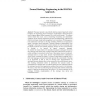115 search results - page 4 / 23 » Formalizing organizational constraints: a semantic approach |
APSEC
2005
IEEE
14 years 1 months ago
2005
IEEE
The lack of a precise semantics for UML activity diagrams makes the reasoning on models constructed using such diagrams infeasible. However, such diagrams are widely used in domai...
ROBOCUP
1998
Springer
13 years 11 months ago
1998
Springer
Abstract. Constraint Nets provide a semantic model for modeling hybrid dynamic systems. Controllers are embedded constraint solvers that solve constraints in real-time. A controlle...
CMOT
2004
13 years 7 months ago
2004
Social action is situated in fields that are simultaneously composed of interpersonal ties and relations among organizations, which are both usefully characterized as social netwo...
PKDD
2009
Springer
14 years 2 months ago
2009
Springer
Abstract. We propose a learning approach for integrating formal knowledge into statistical inference by exploiting ontologies as a semantically rich and fully formal representation...
COOPIS
2002
IEEE
14 years 12 days ago
2002
IEEE
This paper presents a specifically database-inspired approach (called DOGMA) for engineering formal ontologies, implemented as shared resources used to express agreed formal semant...

